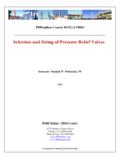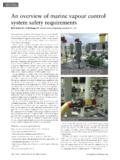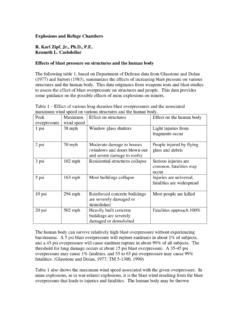Transcription of Flexible Fire Protection Jackets - Advanced Insulation
1 Flexible fire Protection Jackets applications in the oil, gas and petrochemical industries require Flexible , user-friendly fire Protection systems that can be easily fitted without specialist tools. For ease of maintenance such systems should be simple to remove and refit, yet be of durable construction and able to withstand the rigours of service duty. ContraFlex is a range of tailor-made Flexible Protection Jackets developed by Advanced Insulation . ContraFlex is designed to provide high performance thermal Insulation and Protection from jet and / or hydrocarbon fire to equipment which requires frequent maintenance access. ContraFlex Flexible Protection JacketsContents Design fire Hydrocarbon fire Insulation fire rated 120 minH30/H60 AssembliesHydrocarbon rated 60 minH60/H120 StructuresHydrocarbon rated 120 minISStatic Insulation jacket for temperatures from -36 C to +260 CIS HTVibration Insulation jacket for temperatures from -36 C to +650 CBlast ResistanceUp to barContraFlex PerformanceBespoke ServiceTo meet the requirements of the client, Advanced Insulation offers a full bespoke service, which includes survey, design, manufacture and Insulation provides a total environmental lifecycle support for ContraFlex from design to disposal.
2 As a part of the initial survey we offer to dismantle and dispose of any existing fire Protection in order to fit ContraFlex . DesignThe ContraFlex design team utilises Lectra software integrated with Carlson proprietary software for 3D product realisation and the operation of 32 cutting table installed in a mobile production unit. ManufactureContraFlex is manufactured in the form of a jacket, usually 50-61 mm thick. The thickness of the jacket can vary to suit the requirements of the application. Manufacture can be undertaken either at Advanced Insulation s facilities or, where appropriate, at a project site anywhere in the world. The ContraFlex team is headed up by a principal fabrics engineer who has over ten years experience in the manufacture of the Flexible Jackets and an understanding of their applications within the oil and gas industry.
3 InstallationFull installation instructions are supplied with each jacket, detailing how the components fit together around the protected structure. The Jackets are held in place by simple fastening systems, such as stainless steel fixings and / or Velcro straps. Both ContraFlex and the fixings are designed to be easily removable for maintenance, yet are suitable to withstand exposure at the site. Contraflex Mobile Production Unit Fabric cutting table Stainless Steel PlatesProduction Centre3 ContraFlex Flexible Protection Jackets can be readily adapted for use in a variety of applications, such as:Valves and actuatorsWelding nodes ManwaysCable trays, conduits and instrument linesMotorised actuatorsJunction boxesAir receiversProcess vesselsHot equipment exhaustsLocalised protectionDesign Criteria The maximum surface temperatures given in the table below are widely used in upstream offshore installations as default values in determining the passive fire proofing (PFP) requirements for critical equipment which requires Protection in order to allow it to fulfil its function in an emergency.
4 These PFP requirements form an integral part of fire and explosion and mitigation philosophy. Process equipment and piping (vessels, columns, heat exchangers, etc.) likely to contain gaseous, liquid or liquefied hydrocarbon< 350 Riser sections, pipelines and ESDV s, flanges< 200 Riser supports< 400 fire pumps, essential generator< 200 Processing EquipmentStructural ElementsWelding Nodes< 400 Bulkhead < 400 Vessel Skirt /Vessel Support< 400 Deadweight support< 400 Junction boxes and motorised actuators< 100 Cable trays, conduits and instrument lines Umbilical Breakout < 100 TUTU ( Topside Umbilical Termination Unit)< 100 Electrical & InstrumentationContraFlex capability++++++++++ContraFlex Design CriteriaType of equipmentMaximum Surface Temperature ( C)
5 J120H30H60H60H1204 Process EquipmentWhile the individual operators standards vary, the manufacturers specify that the maximum operating temperature of pneumatic and hydraulic valve actuators is 130 C and of motor operated valve actuators 110 C. The ContraFlex Jackets have H30 temperature rise of 11 C and J30 temperature rise of only 30 C. This allows for ambient temperature of equipment of over 55 C and the maximum temperature of equipment in direct sunlight can reach 85 C. StructuresContraFlex is typically used to protect riser clamps, pipe supports and pipelines to ensure that the surface temperature is maintained below 400 C during a J60/J120 event. The bespoke design and fixings enable ContraFlex Jackets to be secured to large structures when required.
6 Each segment of a jacket is designed to be easily handled by one or two people and incorporates lift points to enable individual segments to be lowered to the ground. Weight of each segment is clearly marked on it. 3. Electrical & InstrumentationContraFlex fire Protection for electrical junction boxes is designed to restrict internal temperature rise and to protect the junction box from overheating. ContraFlex has world leading T of 11 C for H30 rating. Riser ESDVC heck ValvesVessel ProtectionPipe SupportJunction Box MountingActuator with access panelLarge Diameter StructureControl panel protectionContraFlex Typical Applications56 Key FeaturesTested to International Standard ISO 22899-1 Third party certified by Lloyds Register, ABSA pproved by State fire Department of the Republic of Kazakhstan Proven capable of withstanding temperatures of 1.
7 350 C for two hours with the back face temperature rising by only 123 C Proven capable of withstanding blast overpressures resistance of bar+++++ContraFlex Jet fire PerformanceContraFlex is tested to both the International Standard ISO 22899-1 Determination of the Resistance to Jet Fires of Passive fire Protection Materials, Part 1: General Requirements and to the guidance criteria of the Health and Safety Executive, Offshore Technology Report OIT 95 634 Jet fire Resistance Test of Passive fire Protection Materials . The test specimen, which was 61 mm thick, was subjected to a propane jet fire with an average mass flow rate of kg/s1 with a heat flux equivalent to 350 kW/m2 and maximum temperature of 1,350 C (2,462 F).
8 The average temperature rise above ambient ( T) was:PropertyValueJet fire resistance (ISO 22899-1)J120 Back face temperature rise (J120)123 CTemperature resistanceFrom -50 C to 1,350 CBlast overpressure barStandard thickness61mmU W/m KMass12 kg/m2 Lloyds Register certificateSAS F090134 ABS Certificate (PDA)12-LD843417A-PDAC ontraFlex Jet fire Performance Jet fire DurationAverage Temperature RiseJ30 T 17 CJ60 T CJ90 T CJ120 T 123 C7 ContraFlex has undergone a series of jet fire resistance tests lasting in excess of 120 minutes. These tests were applied to both tubular and planar test specimens made of carbon steel and protected with ContraFlex passive fire Protection system. The test was undertaken in accordance with the International Standard ISO 22899-1 Determination of the Resistance to Jet Fires of Passive fire Protection Materials, Part 1: General Requirements.
9 The thermal and mechanical loads applied to the material by the jet fire as defined in this standard are similar to those created in large-scale jet fires resulting from high-pressure releases of natural gas. The facility used for this test is independently certified by Lloyds Register for compliance with BS EN ISO/IEC 17025:2000. The ContraFlex jet fire test was witnessed by representatives of Lloyds Register. Key ResultsContraFlex J120 test specimen was subjected to a propane jet fire with an average mass flow rate of kg/s-1 The maximum temperature rise recorded in the specimen by the end of the test was 123 C. After the test, ContraFlex jacket appeared to have suffered only minimal damage to the outermost layer of material.
10 Each of the two circumferential joints and the axial joint remained intact. ContraFlex J120 Pre test ContraFlex J120 During jet fire impingement ContraFlex J120 Post 120 minutes of jet fireContraFlex +++Jet fire Performance ContraFlex has been tested and certified to the International Standard UL1709:2005 thermal programme and has been proven to withstand hydrocarbon fire temperatures of 1,100 C for up to one hour, therefore ideal for the Protection of junction boxes, actuators and similar assemblies which include corners, edges and openings. Stahl 316 SS junction box was encased in ContraFlex jacket with removable panel to enable access to the front panel of the junction box. The design included elements such as corners, edges and openings.





